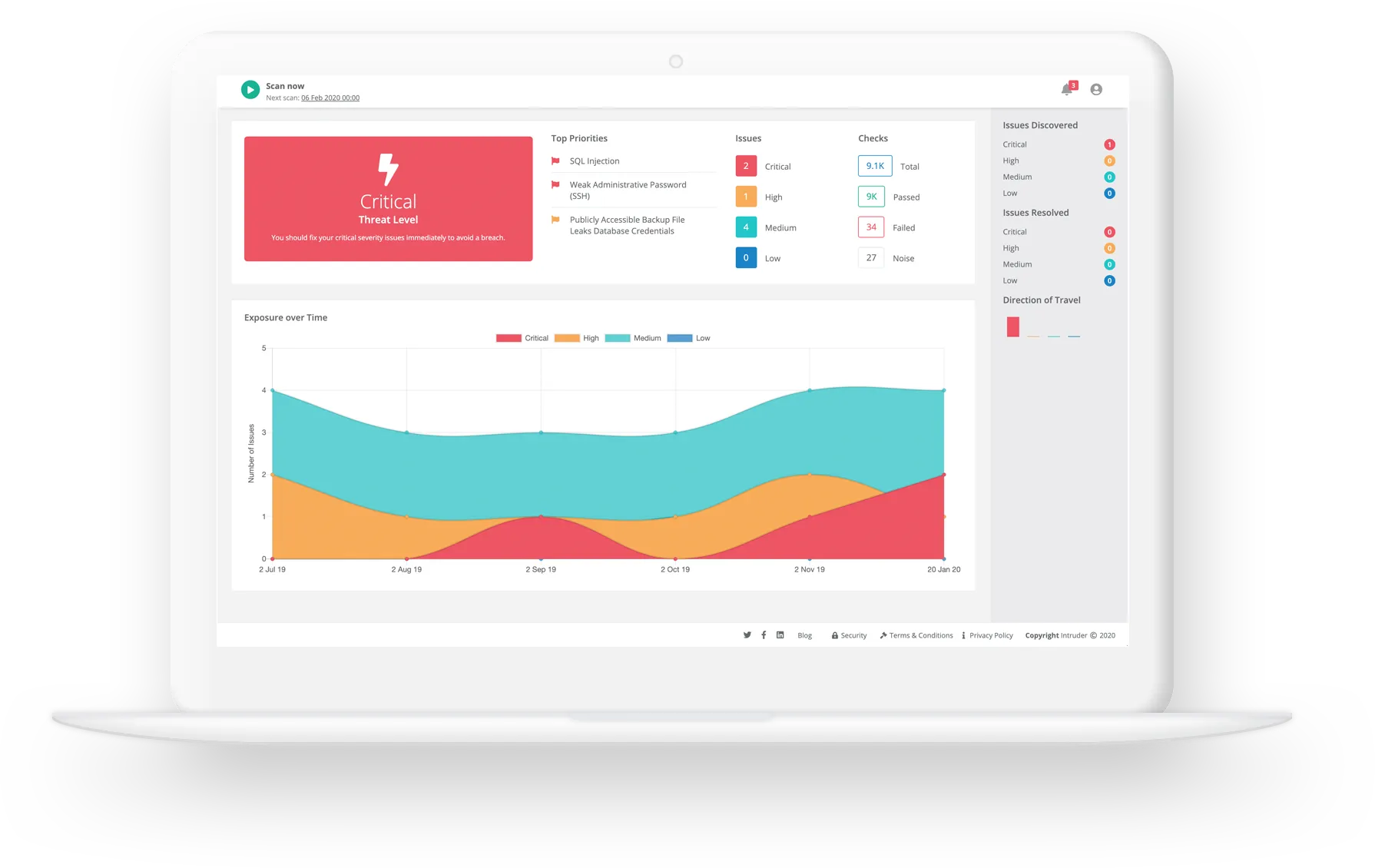Key Points
Mandiant's annual M-Trends report delivers important lessons and deep insights from the cybersecurity frontline for security experts and business leaders alike. Intruder Product Lead, Andy Hornegold, has read the report so you don't have to - here's what he learned.
“Excuse me, but you’ve been compromised”
External sources are now the leading informants of security breaches for organizations on a global scale, with a 63% share of notifications. This includes instances where ransomware actors demand payment. Even allowing for Mandiant’s work in Ukraine, the issue remains that security teams are failing to detect or become aware of compromises on their own.
Every minute that an attacker can spend on your network undetected could cause more and more potentially irrecoverable damage to your organization. The best way to protect your business? By continuously monitoring your evolving attack surface and running continuous, proactive vulnerability scans.
“Will you be staying long?”
On the subject of how much damage a hacker can do in just one minute on your network, the report details the median dwell time that an attacker spends on a network they’ve compromised before they’re detected or have delivered their impact. And, it doesn’t make pretty reading: dropping from 21 days in 2021 to 16 days in 2022.
While 16 days may seem long enough if you have continuous monitoring, there’s still a lot an attacker can achieve if you only run semi-regular scans or penetration tests. The fact that the majority of dwell time is 0-7 days should be cause for alarm too – the ‘smash and grab’ approach is increasingly used by criminals.
“Crime never pays”
Mandiant investigations involving ransomware decreased from 23% to 18% last year, and a few factors are likely to have influenced this. As above, Mandiant’s nation-state work, especially in Ukraine, may have skewed the statistics, but there’s also the ongoing government and legal enforcement efforts to disrupt ransomware services and individuals, which force wrongdoers to find new partners or alter their plans. It is also possible that increased cross-border cooperation is positively impacting operations.
“They’re just taking advantage”
So how are hackers getting in? It would seem that exploits remain the initial attack vector of choice for cybercriminals for a third year in a row. An exploit is a program or code designed to take advantage of a security vulnerability in a computer system or application, in order to infiltrate the system and install malware. Sitting at 32%, exploits continue to beat phishing at 22%, however Mandiant has categorized “internet facing servers” as a separate infection vector with only 2% of the share.

This is a global view but when you break it down by region, it becomes a lot more interesting. In the Americas, exploits are the most common problem at 38%, while in EMEA phishing is the problem (40% of all cases).
Mandiant believes phishing was the top infection vector in EMEA because the US has better phishing protection. Maybe EMEA is actually securing its external attack surface better and the US is lagging behind...
Next on the list is stolen credentials. The average individual has more than one hundred online accounts and will often use the same password for multiple logins, even for crucial business applications and remote connections to their company network. Scary, right? Well, this is why stolen credentials account for 14% of initial attack vectors: a malicious actor requires only one valid password to get in. If this isn’t a reason to place multi-factor authentication on every device and system your organization uses, we don’t know what is.
“What’s it all for?”
Surprisingly, despite the decline in ransomware, data theft cases surged from 29% in 2021 to 40% in 2022. There were many high-profile cases last year. Most notably, in July, a hacker known as 'devil' announced on the BreachForums hacking forum the sale of 5.4 million Twitter accounts' data, which included email addresses and phone numbers belonging to "celebrities, companies, randoms, OGs". The breach was the result of exploiting a vulnerability discovered on Twitter in January 2022.
In November, another hacker published a dataset on the same forum claiming to be personal info for 487 million WhatsApp users from across the globe. These and the many others that took place affected the organizations reputationally and financially. T-Mobile still feels the pain of its data breach in 2021 – shelling out $350 million last year in customer pay outs alone.
“You are the weakest link”
Delving deeper into the analysis, let’s look at specific exploits and how they were (and can be) managed. According to Mandiant's findings, exploits were successfully used in 36% of investigations conducted in 2022, as opposed to 30% in 2021. Adversaries are continuing to rely on exploits to infiltrate and maintain their presence within networks. Notably, perimeter devices accessible via the internet, such as firewalls, virtualization solutions, and VPN devices, are highly valued targets for attackers.
Out of all investigations involving targeted vulnerabilities, the Log4j vulnerability was abused in 16% of cases. Log4j, part of the Apache Software Foundation library, is a widely used logging framework for Java developers, allowing them to log data, including user-generated content, into applications. In December 2021, a critical Remote Code Execution (RCE) exploit was found in Log4j (CVE-2021-44228), affecting all versions prior to 2.15.0. This vulnerability, dubbed Log4Shell, can grant unauthorized access to a server by allowing an attacker to execute code remotely.
Given the widespread use of Log4j, the exploit is regarded as one of the most significant vulnerabilities of the last decade and Mandiant rated the risk as Critical. Using Log4j as a means to gain an initial foothold on a network, hackers wasted no time in going further and exploiting critical services. Due to the sheer volume of compromises, work to resolve and remediate it continued well into 2022.
The second and third most notable vulnerabilities identified by Mandiant related to F5 Big-IP and VMware Workspace ONE Access and Identity Manager. You can get information on how to defend yourself from any of these such risks with our comprehensive guide.
“Where’s the malware?”
CobaltStrike still holds the top spot as the most detected malware family, comprising 15% of detections. Originally created for penetration testing, the tool is unfortunately frequently abused by cybercriminals to gain access to systems illegally.
It’s used by state-sponsored groups in China, Russia, and Iran, but also by six financially motivated groups (FIN6, FIN7, FIN9, FIN11, FIN12) and a staggering 700 uncategorized and currently unattributable groups. CobaltStrike’s usage has been declining since 2021 but runners-up, systembc and metasploit, each hold only 4% of detections.
"Don’t scratch beneath the surface"
At Intruder, we talk a lot about how important it is to protect your external attack surface and Mandiant’s latest findings only reinforce that view. In the table from the report below, which displays a breakdown of the most commonly used MITRE ATT&CK techniques, you can see that nearly a quarter of them exploit public-facing applications. It’s simple really – just put greater focus on your cyber hygiene.

“That’s all folks”
As the report shows, cyber threats are increasing, adversaries are becoming more sophisticated, attacks becoming more automated and indiscriminate, and the responsibilities of IT security teams are getting heavier. Why not lighten the load? Try Intruder for free for 14 days and see how easy it can be to stay ahead of hackers.









.jpg)










